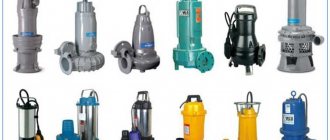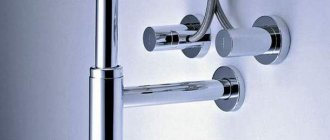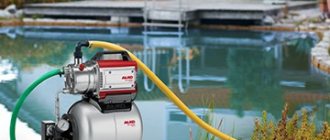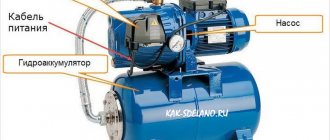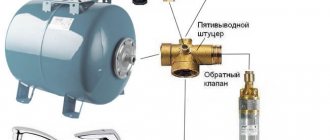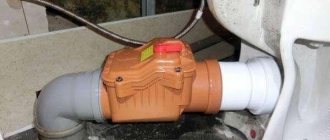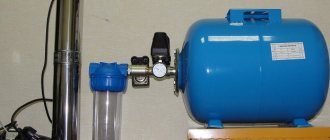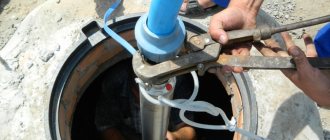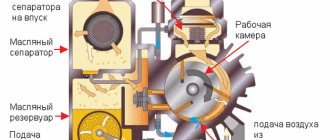A sewerage pumping station (SPS), designed for pumping wastewater, is a whole complex of technical devices, which also includes special tanks. Such stations are used in cases where it is not possible to transport wastewater through the sewer system by gravity. For example, you cannot do without a station if the bathroom is located below the level at which the sewer pipe is installed.
A high-performance sewage pumping station is a cylinder-shaped container, inside of which all the necessary equipment is located
Today you can purchase sewer stations of various modifications, which differ in technical characteristics, design, and scope of application. That is why, before you start choosing such installations, if the need arises for them, you should understand their design features, operating principle, and also become familiar with the main types of such equipment and the differences between them.
Areas of application and purpose of CNS
A sewage pumping station (SPS) is an integral complex of hydraulic equipment, which is designed for pumping storm water, industrial and domestic wastewater when their gravity discharge is impossible.
Pumping stations can have an additional horizontal cavity to distribute sludge over a larger area, which allows for less sludge removal
CNS is used mainly in the following cases:
- The geodetic level of the tanks and pipelines from which wastewater is discharged is located below the sewer or cesspool.
- Lack of physical ability to organize straight-line gravity drainage of wastewater or a small slope of the sewer pipe, which threatens its regular clogging.
- The cesspool or central collector is located far from the source of wastewater.
Cottage villages, country houses, as well as industrial facilities located far outside the city and remote from the centralized sewer network are equipped with sewage pumping stations.
Device diagram
Different types of pumping stations for sewage differ from each other in design, but regardless of the modification, their main elements are a pump and a sealed tank into which waste products are collected. The reservoir with which the sewage pumping station is equipped can be made of concrete, plastic or metal. The task of the pump that is equipped with the sewerage station is to raise wastewater to a certain level, after which it flows into the storage tank by gravity. Once the tank is filled, the wastewater is pumped out and transported to a disposal site.
Middle class pumping station device
Often, the design of a household pumping station includes two pumps, the second of which is a backup and is used in cases where the main one fails. Sump stations serving industrial and municipal enterprises with large volumes of wastewater are required to be equipped with several pumps. Pumping equipment for pumping stations can be of various types. Thus, domestic sewage pumping stations, as a rule, are equipped with pumps with a cutting mechanism, with the help of which fecal matter and other impurities contained in wastewater are crushed. Such pumps are not installed at industrial stations, since solid inclusions contained in wastewater from industrial enterprises, if they get into the cutting mechanism of the pump, can lead to its breakdown.
Construction and connection of a small-sized pump station located indoors
In private homes, mini water pumping stations are often installed, the pumps of which are connected directly to the toilets. Such an aesthetically designed water pumping station (a real mini-system equipped with a pump with a cutting mechanism and a small storage tank) is usually installed directly in the bathroom.
Serial models of sewage pumping stations are equipped with polymer tanks that are buried in the ground, while the neck of such a tank for sewage pumping stations is located on the surface, which facilitates routine inspections, maintenance and repair of the tank, if the need arises. The neck of the storage tank before the start of operation of the pumping station is closed with a lid, which can be made of polymer material or metal. The connection of such a tank to the sewer system through which wastewater enters it is carried out using pipes. To ensure that wastewater flows into the storage tank evenly, a special baffle is provided in its design, and a water trench wall is responsible for ensuring that no turbulence occurs in the liquid medium.
KNS are divided according to their layout into horizontal (left) and vertical (right)
Sewage pumping stations for a private home are equipped with control devices and automatic control mechanisms. Additional elements that are supplied to industrial sewage pumping stations and installations for servicing a home sewer system include:
- a source that provides backup power supply to the equipment included in the pumping station;
- pressure gauges, pressure sensors, shut-off valve elements;
- equipment that provides cleaning of pumps and connecting pipes.
According to the design, SPS are available with submersible pumps, dry version and multi-section
Equipment selection rules
Next, the criteria will be analyzed, taking into account which it is necessary to select sewage pumping equipment for private use. Analysis of industrial installations is beyond the scope of this review.
The goal when purchasing a pumping station is to purchase equipment that is optimal in terms of power and other characteristics. There is no point in overpaying for systems that will operate at 10-20% of their designed capacity.
When choosing a CNS, the following parameters are taken into account:
- Maximum flow of processed waste.
- Transport distance.
- The difference in geodetic levels between the inlet pipe and the outlet of the pressure hose.
- Degree of pollution, fractional composition and structure of domestic wastewater. There are pumping stations that crush large fractions of inclusions, preventing blockages in pumping equipment.
- Level of wastewater treatment required.
- Equipment dimensions.
There is no single formula for calculating the performance of pumping equipment, therefore the calculation algorithm and the necessary indicators must be specified in the instructions for the purchased pumping station.
A typical project for calculating the performance of pumping equipment includes the following steps:
- Determination of daily water consumption and wastewater volume.
- Construction of an approximate schedule for the flow of sewage wastewater during the day.
- Calculation of minimum and maximum sewer flow.
- Determination of the required productivity of the pumping station, taking into account the contamination of wastewater.
After determining the above parameters, you can begin to select the appropriate equipment.
The price of a pumping station is influenced by the manufacturer’s brand, the maintainability of the product, and the possibility of service. It is especially not recommended to purchase cheap pumps if they are expected to be used daily, and there are no reserve tanks or an additional pump for drainage.
Classification of sewer stations
Classification of sewer stations.
The stations vary in size - from compact ones located in the bathroom to tanks with dozens of cubic meters. Dimensions are not the only difference in the models. CNSs are classified according to many other criteria.
The main piece of equipment is the pump.
There are these types of pumps:
- Submersible pressure. They are constantly in the pumped liquid. Therefore, the housings are made resistant to chemically active substances. They do not require a separate space, although they can be installed on a surface if necessary. The pump is constantly cooled, so it lasts a long time.
- Console. Units with large dimensions and power. Used in industry. Installed on a concrete platform.
- Surface self-priming. Capable of pumping sewage with a high degree of contamination and solid inclusions. Easy to maintain. The wastewater is pumped into the station body, from where it is removed clean.
Can be installed in horizontal or vertical position. Placed in recesses on the surface. The main equipment can be recessed, and the control unit can be external.
The management of the stations is carried out according to schemes of varying complexity.
The following types of control are possible:
- Manual - simple and reliable. The modules are started and turned off depending on the level of filling of the tanks, which are checked by a person. They are used in the private sector, with small volumes of wastewater.
- Remote. Sensors monitor the condition of the containers, and the information is displayed on the remote control. It controls the operation of the pumps.
- Automatic. There are sensors and relays in the SPS tank or nearby.
Equipment is also distinguished by type of wastewater:
- For sewage from a private home, small establishments. Operates under standard conditions.
- Industrial. For equipment placed in containers and pumps, materials that are resistant to chemicals and temperature changes are used.
- For storm drainage. Equipped with additional equipment.
- For wastewater with sediment. Mainly used in large sewer systems. Requires additional equipment for working with sediments.
Installation instructions for pump station
Installation of household pumping stations is carried out exclusively by qualified workers, due to the high requirements for the accuracy of work and compliance with the sequence of actions.
Failure to comply may result in damage to the tank or associated pipes. Next, we will consider step-by-step instructions for installing the CNS for people who want to do it themselves.
Step #1 . The location for installation of the pumping station is being selected. SNiPs require digging a tank at least 20 m from the walls of a residential building. If geodetic levels allow, then it is advisable to choose a higher site so that a lot of groundwater does not accumulate under the station.
KNS should not be installed on the front side of the house, near children's playgrounds and near picnic areas
Step #2 . A hole is dug taking into account the diameter of the container and the location for convenient installation work. If the soil is obtained by an excavator, then work must be stopped 20-30 cm above the design level. Next, the soil must be removed manually with a shovel to maintain the integrity of the soil.
When digging a hole for a sewer tank, you do not need to make it huge. A diameter 1.5-2 meters larger than the size of the container itself will be sufficient.
Step #3 . The type of foundation for installing the water pumping station is selected and installed. To do this, after digging a hole, the soil water content is assessed. If the soil is dry, then you can make formwork and fill it with a 30-centimeter layer of concrete.
And if groundwater constantly seeps into the pit, then only a ready-made reinforced concrete slab with a thickness of at least 30 cm is suitable for the foundation.
The concrete base must be strictly horizontal, so when laying the finished concrete slab you need to take care of this in advance.
KNS containers have a skirt or legs for attaching to the foundation. Anchor bolts are used as fasteners, although when pouring concrete onto the ground, metal rods can also be built into the mixture, onto which the container can then be attached.
You should not skimp on the size of the anchor bolts. Their optimal length is 200 mm and diameter is 20 mm. And before laying in liquid concrete, metal rods must be bent with a hook or the letter G (+)
Step #4. The water pumping station tank is installed on the foundation, secured and connected to the drain pipe of the internal sewer system of the house. With a vertical type of station and a large amount of groundwater, it is necessary to load the container with concrete. To do this, concrete is poured around the tank 20 cm above the level of the first stiffener of the station.
It should be borne in mind that after pouring concrete it will be impossible to change the tank, so it is necessary to calculate its volume taking into account the expansion of the house and the increase in the number of its residents
Step #5 . The station is backfilled with fine soil, the maximum grain size of which is 32 mm. Each layer of earth should be no more than 50 cm. After filling the next belt, it is filled with water for shrinkage and compacted.
This completes the external installation of the pump station. After being fixed in the ground, pumps, sensors, check valves and other auxiliary equipment are installed inside the station.
For safety reasons, it is recommended to close the hatches of sewer tanks with locks, because while playing, children can hide in them and lose consciousness
It would not be superfluous to install an emergency warning system in the house about the critical level of domestic wastewater in the tank, which will warn about malfunctions in the operation of the station.
Basic characteristics of the pavilion for pumping stations
Forced exhaust ventilation of the pavilion
The container for pumping station has the following technical indicators:
- Third degree of fire resistance;
- The fire hazard category of the pavilion is C0;
- The design temperature outside at which the room can be operated should not fall below minus 50 degrees;
- The internal temperature in the container must be at least plus 5 degrees;
- The maximum possible pressure of snow cover on the roof is 145 kg/cm²;
- The wind pressure on the pavilion walls should not exceed 48 kg/cm².
Typical installation errors
Damage to tank walls, connections or associated pipes can occur if the tank is not installed correctly, tilted or backfilled incorrectly. Such problems threaten manual excavation of the container and considerable financial costs.
Therefore, you should sort out typical mistakes in advance so as not to repeat them when installing your own pump station.
- Incorrect soil filling. Possible mistakes: filling with frozen soil or large stones, lack of layer-by-layer compaction. The consequence may be subsidence of the earth with damage or displacement of the internal pipeline.
- Different type of backfill from different sides . If you poured sand into the pit on one side and earth on the other, then over time the container may become distorted, causing damage to the external pipes or the tank itself.
- Incorrect assessment of the amount of groundwater , which causes severe subsidence of the entire pumping station with rupture of pipes and damage to the reservoir.
- Using wedges to level foundation slabs . The consequence may be a gradual displacement of the tank to the side with rupture of pipes.
Only people with geodetic education and experience in installing similar structures can evaluate the correct installation of the SPS. Therefore, you should not trust the installation of this expensive equipment to non-specialized organizations.
Maintenance of external pump stations
A sewage pumping station is not equipment that you can install and simply be content with its operation. The tank and pumps require regular inspection.
It is strictly prohibited to go down into the tank or carry out cleaning work on your own!
Inhalation of sewer gases can cause sudden loss of consciousness and death if the person is not removed to clean air within a few minutes.
The most profitable option for regular cleaning of a sewer tank is to purchase a gas mask with forced air supply from the surface
When purchasing a water pumping station, it is advisable to immediately sign a contract for its maintenance.
To access the tank and check the equipment, the stations have a hatch, and deep tanks also have a ladder for descent.
Monthly or quarterly, the service department must:
- check the automation;
- diagnose the operation of the main and backup pumps, check the oil levels in them;
- remove stuck debris from filters;
- remove silt deposits from the bottom.
In case of urgent emergency situations, an independent inspection of the tank is possible, but it must be carried out in the presence of assistants, with a rope harness and wearing a respirator.
What is included in a typical CNS:
| No. | Name | Quantity, pcs.) |
| 1 | Pumping station housing | 1 |
| 2 | Those well | 1 |
| 3 | Metal frame for mounting pumps | 1 |
| 4 | Stainless steel pipe | 2 |
| 5 | Gate valve | 2 |
| 6 | Check valve | 2 |
| 7 | Ladder | 1 |
| 8 | Pump guides | 4 |
| 9 | Inlet pipe | 1 |
| 10 | Outlet pipe made of stainless steel | 1 |
| 11 | Lockable hatch | 1 |
| 12 | Ventilation tube | 1 |
| 13 | Cable channel for powering pumps | 1 |
| 14 | Service platform | 1 |
| 17 | Pump from GRUNDFOS, KSB, WILO, ZENIT or any other | 2 |
| 18 | Automatic pipe coupling | 2 |
| 19 | Internal control panel (remote control) | 1 |
| 20 | Float switch | 4 |
